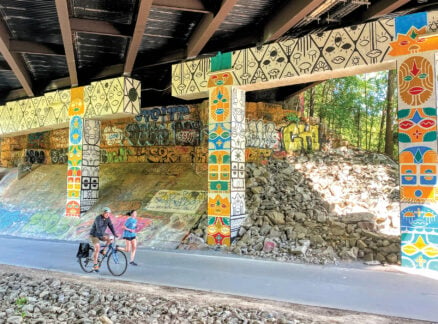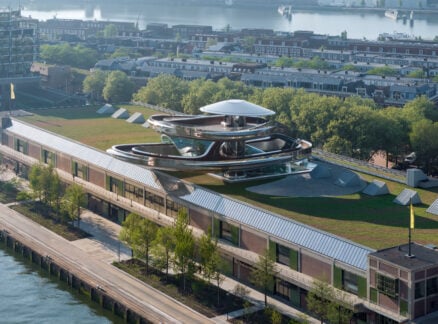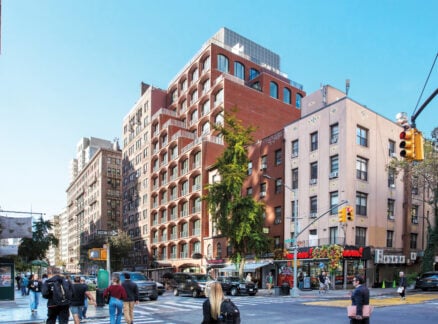April 19, 2005
The Multifaceted Ron Arad
Ron Arad creates functional high art. He would disagree with that description, waving it off as far too pretentious, but the fact remains that Arad designs furnishings, interiors, installations, public art, and buildings that are sensuous and sculptural, yet still eminently usable. Having been trained as an architect, he began his career as a product […]
Ron Arad creates functional high art. He would disagree with that description, waving it off as far too pretentious, but the fact remains that Arad designs furnishings, interiors, installations, public art, and buildings that are sensuous and sculptural, yet still eminently usable. Having been trained as an architect, he began his career as a product designer, co-founding the company One Off with Caroline Thorman in 1981. The studio’s mix of high-end furniture and experimental, limited-edition chairs cemented Arad’s reputation, as well as accentuated his fascination with process and materials. In 1989, Arad and Thorman established a second entity, Ron Arad Associates, an architectural and design practice.
Arad’s upcoming exhibition in New York—his first in the city since 1987—is so extensive that it necessitates two venues. Arad’s early and rare furniture, including Aerial Light and the Rover, Big Easy, and At Your Own Risk chairs, will be the focus of “Retrospective Exhibition 1981-2004,” to be held at the Barry Friedman Gallery May 5-June 24. “New Works & Installations,” which will run May 7-June 17 at Phillips, de Pury & Co., will center around the new B.O.O.P. Oh Void chairs, as well as Lo-Rez-Dolores Tabula Rasa, an installation made of Corian and studded with fiber optic cables through which film and images can be projected. The exhibitions will be accompanied by a catalogue with essays by Issey Miyake, Jean Nouvel, and Reed Krakoff, among others.
I spoke to Arad, who was at his north London studio, via telephone.
**
How did the two New York shows came about?
The Barry Friedman Gallery started collecting our stuff, initially without me knowing. Then they got in touch and wanted to do a show. We thought the gallery was OK for collectable pieces, mainly 80s stuff, but it’s not very suitable for the installations we have been doing in the last few years, like Lo-Rez-Dolores. So we decided to get the additional space at Phillips.
Have you seen Lo-Rez-Dolores?
Yes, I saw it at the Venice Architecture Biennale.
You’ve seen part of it. But a major piece of the installation was not ready then; now it is. It now includes an independent, stand-alone film that Mike Figgis shot for it.
What are the two new chair designs that you will show at Phillips?
Are you familiar with the blown aluminum pieces that we made, the Oh Void? And the carbon-fiber Corian chairs that we did? The chairs that we will show will be very similar, but made in blown aluminum and woven aluminum. We made the first pieces last week and weekend, and they are being polished now.
Were you pleased with how they came out?
Until the weekend, the chairs were fiction. It was a theory that they would work, that we could do them. But we’ve done them and they’re good.
Looking over you work, you seem to have a love affair with production methods, searching out—and dreaming up—new ones. How do you keep so current?
First of all, there are lots of new things in the world: new software, new materials, new processes. And they’re just waiting to be used. It’s not that I go shopping for them; they present themselves. There is almost no point in doing something again. Instead, the point is to change a part: change the function, or shape, or material and process.
About the hotel rooms you are working on at the Hotel Puerta America in Madrid. That project came out of the Grand Hotel Salone that you participated in at the 2002 Milan Furniture Fair. How is the actual room different from those earlier sketches?
In the Grand Hotel, the project was omni directional: you were in the middle of a cylinder, with projection all around it. Which is possible to do, but it has its problems. But lots of the ideas were kept for Madrid: the room arrangement, the circular bed.
Do you enjoy doing hotels? You are also working on the Upperworld Hotel atop London’s Battersea Power Station, for example.
I’m not especially attracted to hotels; it seems hotels are attracted to us now. I enjoy projects that have the possibility of doing something interesting. Battersea Power Station is a very, very interesting building. It was a bit strange, to have a hotel on top of it—and a super-luxury hotel, at that. But it’s a great project.
What other projects are you working on?
We’re doing the headquarters building of the Italian company Magis; we’re doing a little village for them [in Treviso, Italy] on a virgin piece of land. We’re doing a design museum outside of Tel Aviv. We completed a scheme for a hotel in the Alps for Szwaroski—the Hotel at the Kristallwelten, in Wattens, Austria.
[Aside, to co-worker—“I remember it! Don’t accuse me of leaving out one of the children!”] And there’s also a hotel in Rimini. There’s a fantastic hotel—Hotel Duomo—in Rimini, Italy.
You have a degree from the Architectural Association in London. But for many years, you concentrated on interior pieces, rather than architecture. What is it like for you going back to designing more architecture?
It’s not going back. The difference between industrial design and architecture is that for architecture, someone has to be brave enough to commission you to do something. With pieces of furniture or design, you just make them, especially the studio pieces. This is how I started my career. How a project is initiated is also different. Architecture involves more people: clients, town planners, the firemen—it’s a more complex process. The time scale is different, and the scale is different—full stop.
I don’t prefer one field more than the other. My preference is for what’s lasting and for what the new excitement is. It could be in architecture, it could be in industrial design. Or it could be in doing useless things.





